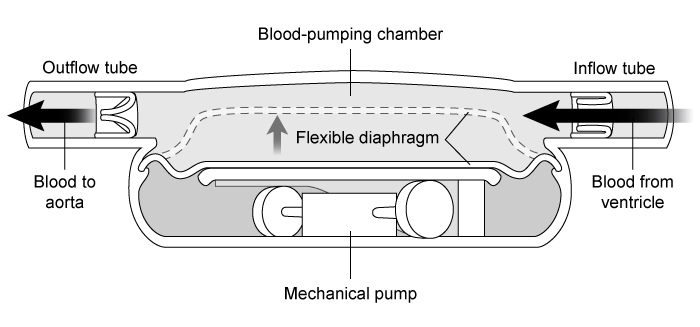Passage
In the event of end-stage heart failure, a left ventricular assist device (LVAD) can be used as a heart transplant bridge to keep a patient alive. The first iterations of LVADs were pulsatile and mimicked the physiological pumping action of the heart (Figure 1) .
 Figure 1 A pulsatile-flow LVAD schematicA pulsatile-flow LVAD assists ventricular systole by mechanically pumping blood from a weakened left ventricle into the aorta through a pair of one-way valves. The pressure differential ΔP generated by the pump is related to cardiac output (CO) and vascular resistance (VR) :ΔP = CO × VREquation 1The efficiency and performance of the heart (or LVAD) can be determined by the patient's cardiac pressure-volume (PV) loop. A cardiac PV loop plots the pressure and volume of the blood in the left ventricle throughout a single cardiac cycle (Figure 2) .
Figure 1 A pulsatile-flow LVAD schematicA pulsatile-flow LVAD assists ventricular systole by mechanically pumping blood from a weakened left ventricle into the aorta through a pair of one-way valves. The pressure differential ΔP generated by the pump is related to cardiac output (CO) and vascular resistance (VR) :ΔP = CO × VREquation 1The efficiency and performance of the heart (or LVAD) can be determined by the patient's cardiac pressure-volume (PV) loop. A cardiac PV loop plots the pressure and volume of the blood in the left ventricle throughout a single cardiac cycle (Figure 2) .
 Figure 2 Cardiac PV Loop of a pulsatile-flow LVADBlood pressure is often represented by only two numbers: arterial systolic and diastolic pressures. A more detailed representation of blood pressures is shown in a blood pressure profile, which graphs the blood pressure throughout the length of the different vessel groups (Figure 3) . Multiple pressure fluctuations are shown within a vessel because the pressure is traced across multiple cardiac cycles.
Figure 2 Cardiac PV Loop of a pulsatile-flow LVADBlood pressure is often represented by only two numbers: arterial systolic and diastolic pressures. A more detailed representation of blood pressures is shown in a blood pressure profile, which graphs the blood pressure throughout the length of the different vessel groups (Figure 3) . Multiple pressure fluctuations are shown within a vessel because the pressure is traced across multiple cardiac cycles.
 Figure 3 Blood pressure profile of the different vessels
Figure 3 Blood pressure profile of the different vessels
-The mean arterial pressure (MAP) is used to approximate the average blood pressure of an individual's arteries:MAP = DP + (SP - DP) /3where DP is diastolic pressure and SP is systolic pressure. What is the MAP for the blood pressure profile shown in Figure 3?
A) 40 mm Hg
B) 80 mm Hg
C) 100 mm Hg
D) 105 mm Hg
Correct Answer:
Verified
Q68: Passage
In the event of end-stage heart failure,
Q69: Passage
In the event of end-stage heart failure,
Q70: Passage
Sound waves propagate through many conducting structures
Q71: Passage
Positron emission tomography (PET) is a medical
Q72: Passage
Positron emission tomography (PET) is a medical
Q74: Passage
In the event of end-stage heart failure,
Q75: Passage
Positron emission tomography (PET) is a medical
Q76: Passage
Ultrasound is a technique that uses the
Q77: Passage
Ultrasound is a technique that uses the
Q78: Passage
Positron emission tomography (PET) is a medical
Unlock this Answer For Free Now!
View this answer and more for free by performing one of the following actions

Scan the QR code to install the App and get 2 free unlocks

Unlock quizzes for free by uploading documents